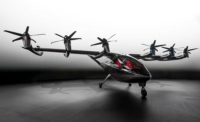Most R&D activity in the auto industry these days is focusing on electric power trains and autonomous vehicles. But, efficiently assembling those products tomorrow will depend on harnessing state-of-the-art production tools and processes today.
To address that issue, Ford Motor Co. recently unveiled a $45 million Advanced Manufacturing Center in Redford, MI. The 100,000-square-foot facility is packed with a wide variety of cutting-edge technology, including drones, exoskeletons, mobile robots and vision systems. Engineers are also exploring new ways to deploy additive manufacturing, augmented reality and collaborative robots on the factory floor.
“These technologies are no longer simply a Hollywood vision of the future,” says Joe Hinrichs, Ford’s president of global operations. “They are critical tools to improve the complex and demanding task of building cars and trucks.
“More than 100 years ago, Ford created the moving assembly line, forever changing how vehicles would be mass-produced,” adds Hinrichs. “Today, we are reinventing tomorrow’s assembly line—tapping technologies once only dreamed of on the big screen—to increase our manufacturing efficiency and quality.”
“Additive manufacturing is a major focus of the new facility,” says Mike Mikula, chief engineer. “Today, [we are] driving the future of 3D printing in the automotive industry.”
The Advanced Manufacturing Center is equipped with 23 printers from suppliers such as Carbon, Desktop Metal, EOS, ExOne, HP, Stratasys and Voxeljet. That variety enables Ford engineers to experiment and study new ways to build parts from a wide mix of metal and plastic materials.
“One application currently under development has the potential to save [us] more than $2 million,” claims Harold Sears, Ford’s technical
leader for additive manufacturing. “As [the technology] becomes more affordable, [printed] parts will become more prevalent.”
Ford has already deployed 90 3D printers globally. For instance, all of the company’s power train assembly plants are equipped with Stratasys F370 machines that can produce replacement parts needed for equipment maintenance applications.
“On the shop floor, workers team with advanced manufacturing experts to identify ways to save the company time and money,” says Hinrichs. “[For instance, they can] print replacement parts to keep lines running instead of waiting for parts that can take weeks to be fabricated.
“Printed parts also help employees improve vehicle quality,” adds Hinrichs. “Assembly line workers at the Michigan Assembly Plant, where [we] build the Ranger pickup, use five different 3D-printed tools. They played a critical role in the launch, removing weeks from an already tight timeline and ensuring quality was built in from the first vehicle that rolled off the line.”
Additive manufacturing is being used to produce replacement parts for older models of the Focus compact sedan. And, when the Shelby Mustang GT500 debuts at the North American International Auto Show in Detroit this month, it will feature two printed brake parts.
Ford has also been investing heavily in collaborative robots. According to Hinrichs, the automaker already has more than 100 machines deployed in 24 plants globally.
“At the Livonia Transmission Plant, a cobot performs a job that was so ergonomically difficult for employees that they could only do that job for one hour at a time,” says Hinrichs. “The cobot was a welcome addition to the production line.”
“Utilizing cobots in the Advanced Manufacturing Center allows [us] to identify and address potential production issues before they are installed in plants,” adds Mikula. The facility is equipped with machines from Fanuc, Kuka and Universal Robots that can handle payloads up to 35 kilograms.
In another part of the open-plan floor space, Ford engineers are using Microsoft HoloLens headsets to design assembly lines and study ergonomics using augmented reality.







